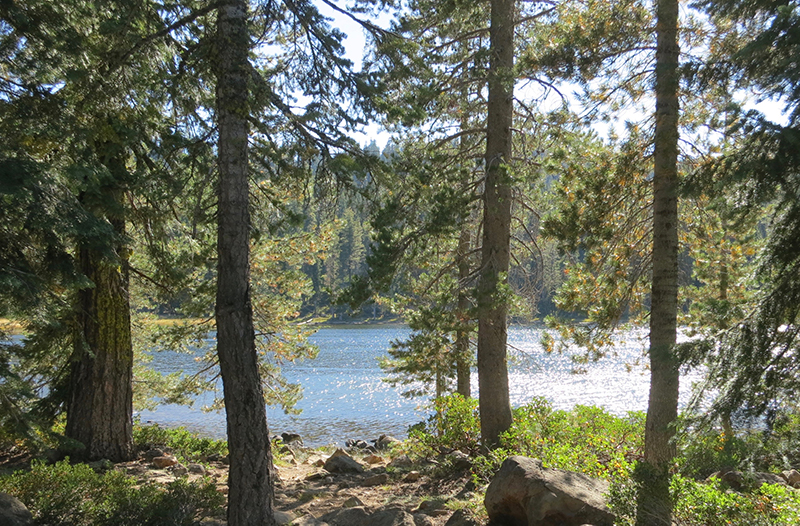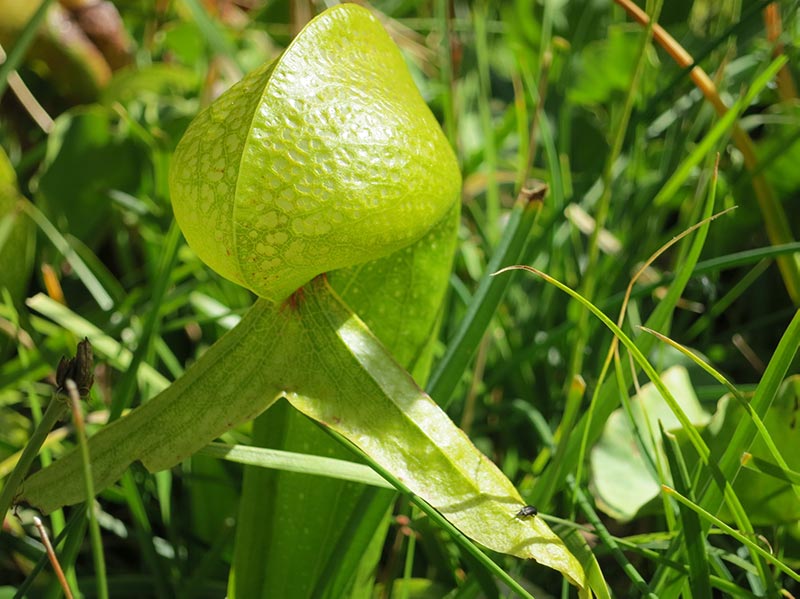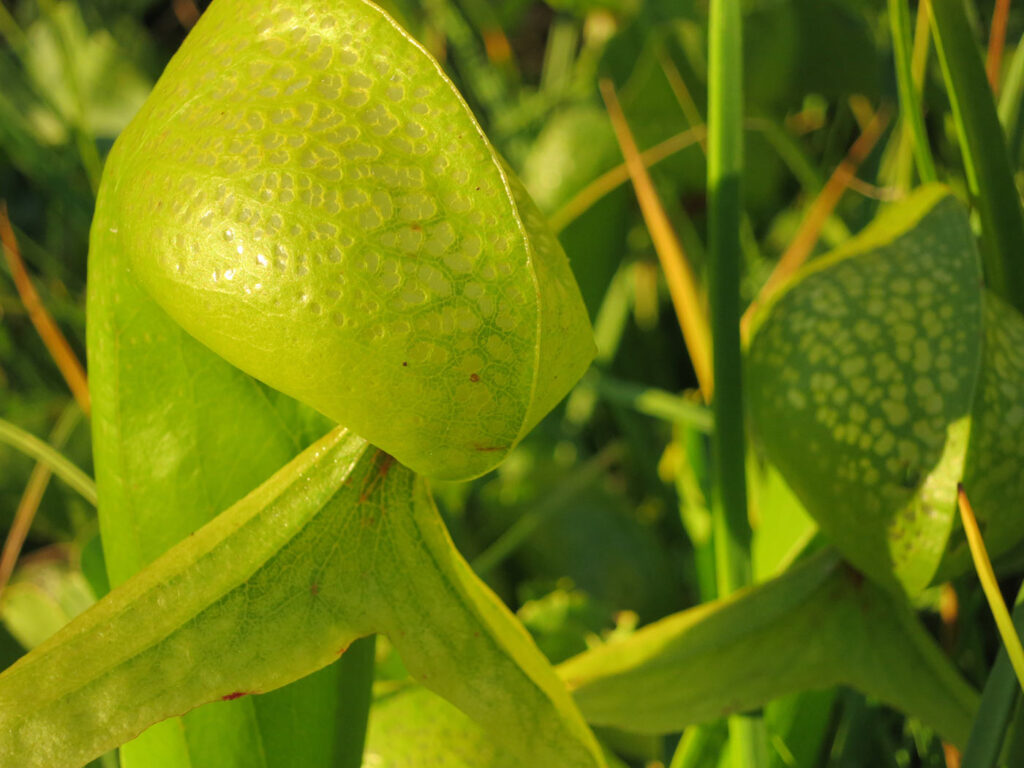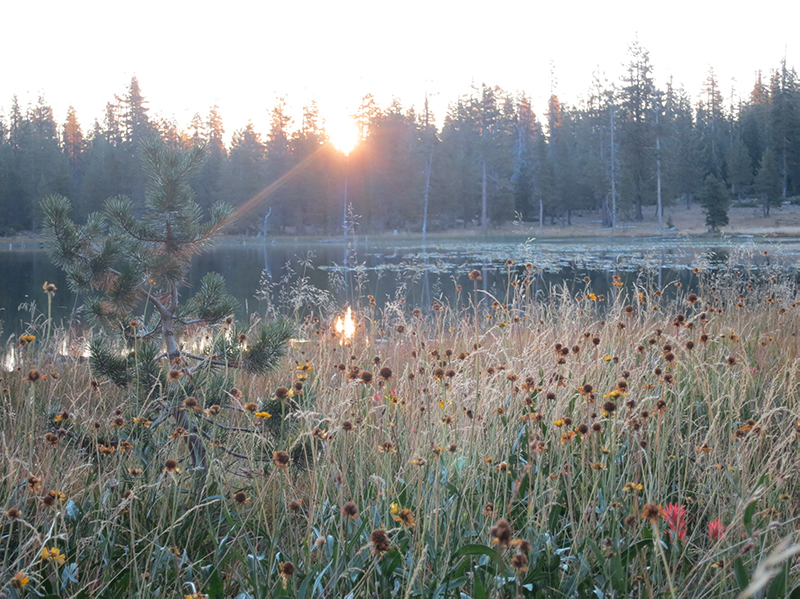People go camping for a variety of reasons. Andy Murdock wanted quiet and a chance to check out an unusual carnivorous plant. But there were others at the same Northern California campground for a very different reason — and mysterious screams in the night.
It’s said that when humans mastered fire, it brought us the power to conquer the darkness. Whoever says grandiose things like that hasn’t spent much time around campfires. A glowing fire makes the darkness beyond the reach of its light feel even darker. When you’re camping and the sun sets into a moonless night, the horizon shrinks to a radius of just the few meters illuminated by the firelight.
When you wander out into the darkness to see the stars or water the trees, you see one thing fire does quite well: it allows whatever is lurking in the darkness to have a clear view of everything that happens around the fire. This unsettling thought has occurred to me more than once, but I don’t dwell on it. I’m typically more concerned with where I put the cookies than what lies in the darkness — unless that’s where the cookies are.
But on a chilly autumn night camping along the shore of Gumboot Lake, a scream came from woods, and my priorities suddenly changed.
Strange things happened at Gumboot Lake the moment we arrived. They began with The Liar.
We were hunting for solitude. Midweek, after school was back in session, at an out-of-the-way campground in Northern California west of Mt. Shasta, we expected the place to be empty. That was the point: find somewhere with as few people as possible.
This year it was just three of us: me, my brother, Aaron, and our old friend Steve. We’ve been doing some variation on this trip for years, a small group of friends, scouting for new spots around California, looking for those 45-minute-drive-down-a-bumpy-road kinds of places that guarantee a quiet, peaceful spot, away from crowds, drunken yahoos, and RVs with noisy generators. If there were going to be any drunken yahoos in the campground, it would be us.
As we pulled into the campground, it was clear that we had miscalculated. Every campsite was taken. We managed to find one informal overflow spot on a little dirt track along the eastern shore of the lake. There was no table, no steel lined fire pit, just a flat space with a hastily built rock ring that had hosted a fire or two. That was it: take it or leave it. We took it.
Why the campground was busy, none of us could guess. You won’t find Gumboot on a list of prettiest mountain lakes in California, but it’s a pleasant spot with easy access to a beautiful stretch of the Pacific Crest Trail and remote enough to lose the crowds. Usually. If it was this packed at Gumboot Lake, we figured, why risk losing the one spot we had by gambling on space at the more popular campgrounds in the area?
We got out of the car to stretch our legs and scope out the site. It had room for a couple tents, only a handful of trees between us and the water, and we were far enough from the main part of the campground that we felt mostly in our own little world. I walked to the lake to do that thing that cityfolk do when we find ourselves at mountain lakes: stare out over the water, letting the quiet ripples of light and breeze slowly rinse the city off you. This would do nicely.

My reverie was short-lived. A man — white, early 30s, ripstop pants, baseball cap, looking fresh from a Bass Pro shopping trip — approached along the lakeshore heading toward the center of camp.
“How’s it going? You guys with the group?” he asked, smiling. He clearly assumed we were.
“There’s a group?” I asked. “I guess that explains why the place is so full. We weren’t expecting to see much of anyone around here.”
“Oh, yeah,” he said, surprised. “There’s a group of maybe 20 or 30 of us.”
“Reunion of some sort?” I asked.
“No, we’re here on a biological survey.”
This added up. He had a generically outdoorsy weekend naturalist look about him. If he had pulled out a pair of binoculars to track the flight of an osprey across the lake, I wouldn’t have been surprised.
“In fact,” he added, “I just walked around the lake, and there’s a big patch of some kind of carnivorous plant on the far side. It’s really cool, you should check it out.” He waved in the general direction.
Just his luck: out of everyone in the world, he ran into me, a California plant nerd with a head full of Latin plant names that I can recall faster than my own phone number.
“That’s right,” I said, “Darlingtonia californica. I’ve seen it here once before.”
The Latin caught him off guard. I had intended it as a sort of biologist’s secret handshake, but he looked confused.
“What was that again?” he asked.
“Darlingtonia. The cobra lily. Pretty rare to see it in the wild, and this is one of the best patches I know.”
I had scoped out Gumboot Lake a year earlier, and slammed on the brakes when I spotted a small patch of cobra lilies along the road. It was one of the reasons I had suggested this spot for our camping trip, though I had probably neglected to mention that particular detail when pitching the idea.
“Wow, okay, cool,” he said, eyes glazing.
“Are you with a university?” I asked.
“Oh, well…we’re from all over. Kind of a loose group of friends. We meet up occasionally to survey interesting places,” he said. It was a dodge. He suddenly seemed uncomfortable, though I couldn’t begin to guess why.
“What are you surveying for?” I was probing a bit now.
“Just a general survey. We just want to see what’s around here.” He was getting increasingly fidgety, and just as I was starting to get interested, he cut it short.
“Well, you guys enjoy,” he said and walked away toward the center of the campground.
Why did he have to ask if we were with the group if it was a group of friends? Who organizes vague biological surveys late in the year after school is back in session? Something didn’t add up.
I walked back to the campsite, processing the conversation.
“Who was that guy?” Aaron asked.
“I don’t know, but he was a liar.”
It’s worth taking a moment to introduce the cobra lily. It’s neither a cobra nor a lily, but the name is spot-on: the inflated leaves look more like the arching heads of serpents than leaves. It’s veined with a translucent web of green with splashes of crimson as they age and the snake-like effect is completed by a keeled hood and what almost looks like a long forked tongue. Even those who happily walk through life blind to plants around them will stop and wonder at the sight of them.

If you happen to be a flying insect who buzzes into a patch of cobra lilies, though, you’re in for a different experience. At first, everything’s calm. Unlike the Venus flytrap, cobra lilies don’t move, they lure. The forked tongue-like structure displays droplets of sweet nectar. A pungent blend of volatile fruit-like fragrances waft up from somewhere. Colors only visible in the UV range show you where to land. When you land on the tongue, you can tell where the scent is coming from: a small, circular opening tucked under the hood. Crawling through the hole, you find the inside is very waxy and slippery. Then you tumble down a long tube into a pool at the bottom.
When you try to leave, something is very wrong. You can see daylight above, but angled hairs make it hard to ascend. When you manage to fly up toward the light, you bump into a wall you didn’t see: clear “window cells” look like paths to freedom, but are as solid and unyielding as the rest of the tube.
You slip back down the waxy chute.
You try again, but each time the same thing happens. How did you get into this place again? Wasn’t there a hole somewhere? Each attempt makes you more and more tired, until finally you sink into the pool of fluid at the bottom and drown. Trust me: you don’t want to know what the bacteria and mites living in the plant do to your body after that.
A full campground and a random liar didn’t dissuade us. We had a private site, a lake view, and the idea of getting back in the car seemed terrible. We were staying.
We set up our tents, built up the fire pit with some new rocks, scrounged for some kindling in the nearby forest, and grabbed baseball gloves to play catch along the dirt road — a fun but painful reminder to the muscles in my shoulder that I don’t do this more than once a year.
A car pulled up and a man asked out the window, “Are you with Bill’s group? Is this where we’re supposed to be?”
We didn’t know Bill. We didn’t know where he was supposed to be.
A little while later, another man walked past and asked, “You boys here with the BFRO?”
BFRO. Biological Foray Research Organization? Bullshit Friends Roving Outdoors?
The Liar had said it was a group of friends, yet no one seemed to know anyone else. The Liar looked outdoorsy, the next person looked like a pediatrician, another was an IT guy straight from central casting. They all saw three nondescript white men camping and immediately assumed that we were part of the group, whatever this group was.
The scream echoed across the lake. It was the first of several.
We had finished our dinner, played Hearts, and settled into chairs around the fire with some bourbon and cookies. We were puzzling out why The Liar would need to lie and who this group of mysterious campers might be when the first shrill howl from the far side of the lake interrupted us.
We turned toward the darkness. There was nothing to see — too far, no lights in the woods, our own fire too bright. Then it happened again. The howl was animal, but also clearly human. It wasn’t someone in distress or angry — if anything it sounded somewhat…horny.
“Somebody’s been drinking,” my brother said.
By the third or fourth time, we decided to join in. Horny animal call. Exaggerated drunken response. Horny animal call. Even more exaggerated drunken response. We were having a great time. The howling monster person doing whatever it was they were doing in the woods? Unclear.
Eventually, whoever it was fell silent, leaving the crackle of our fire and a growing chill in the air. I grabbed my headlamp and picked my way along the small track toward the center of the campground to find the bathroom. Something was bothering me, but I didn’t put my finger on it until I started heading back to our site. It was dark but not late, somewhere in the 9 o’clock hour, yet in a completely full campground, ours was the only lit fire. There was darkness at every other campsite, as if everyone had disappeared — but all of the cars, all of the tents were still there.
I hurried back to camp. “Guys,” I said, “I think we’re in the middle of a Bigfoot hunt.”
I got up before sunrise to spend time with the cobra lilies. When I’m camping, my brain will click on when the barest light of the day is visible. It’s a great time to grab a camera and take a stroll, to capture the fleeting golden moments of the morning light, and scope out the flora.
My theory that we were surrounded by Bigfoot hunters was met with amused skepticism by Aaron and Steve. They agreed it was a possibility, but only I was completely convinced. I needed more evidence.
But first, I wanted to visit the cobra lilies. The largest patch at Gumboot Lake is on a wet slope, a boggy seep with water oozing out of the soil, trickling slowly down to the lake below. Even in the cold morning, before most insects are active, the bog feels alive with action, rich with decay. It’s a hard place to get a solid footing. Just being there feels itchy. You can’t kneel or sit without getting soaked. I sacrificed a pant leg to get a closer look and snag some photos of the cobra lilies in the early light of day. It was a fair trade.

How did these peculiar and complex traits evolve? Why don’t local insect populations learn to avoid them? Is the community of microbes inside the cobra lily leaves the same in every place? Every question answered raises several new ones in its wake. The more I learn about the natural world, the more I realize how little we know about things that are right in front of us everyday, much less rarities like the cobra lily.
There’s a bias in the sciences known as the “streetlight effect.” It comes from an old joke where a policeman sees a drunk man searching for something under a streetlight at night. The drunk man says he has lost his keys, so the policeman kindly stops to help him look. After a few minutes with no success, the policeman asks, “Are you sure you lost them here?” The man replies, “No, I lost them in the park, but this is where the light is.”
We often look for things where it’s easiest to look, not where we’re most likely to find the answer. It’s easy to think we have the full picture, when we don’t know what lies beyond where we looked because we simply haven’t looked there yet. But it doesn’t mean that the truth is out there waiting for us in the dark.
We put the mystery of these other campers on hold for the day, taking a day hike on the Pacific Crest Trail. For the evening, I had plans to do a little reconnaissance into the main part of the campground to gather more evidence for my theory. I didn’t have to: the evidence came to us.
As we started our dinner, all the other campers gathered at a campsite just across the tip of the lake from us. It was time for an audio presentation, amplified through two large portable speakers. Sound carries across water, so we got free seats for the show.
The recording first presented a series of animal calls to aid identification in the wild: wildcats, coyotes, some unidentifiable howl, bears, wolves, that same unidentifiable howl repeated. It sounded vaguely familiar. After a time, the audio switched to recordings of phone conversations, 9-1-1 calls.
“I just saw a… I don’t know. A big creature crossed the road. It was standing upright. It jumped down off the road into the woods and then I couldn’t see it anymore.”
“Where did this happen, sir?”
“Right in front of my truck, on my way home…”
We had come to Gumboot Lake expecting to find nobody; they had done the same. They were having a Bigfoot hunting party and we crashed it. It explained everything: the strange howls in the woods, the campground that emptied at night, a man on a “biological survey” that he wouldn’t define.
I was torn between screaming with delight and desperately wanting to catch every word drifting across the water. Aaron and Steve felt the same. If you had walked into our campsite at the moment, you would have seen something that looked like a crazy mime celebration: three grown men, wide-eyed, jumping around gesticulating wildly while trying to stay completely silent.
With the mystery out of the way, our question changed from “What the hell is going on here?” to “Now what do we do with that information?” I had to learn more about what these Bigfoot hunters were up to. Answer one question, it raises many more. What’s involved in a Bigfoot hunt? What type of people are drawn to a Bigfoot hunt?
As we strolled down to the center of the campground after dinner, we chatted idly about the day, tossed a few pebbles into the lake and tried to look as nonchalant as possible while scoping out the scene going on around us. At each campsite, people were decked out in camos. In place of weapons, various electronic gadgets were being readied. Sitting on the gate of a truck bed, one man was making sure the straps on his night vision goggles fit snugly. No one paid us any mind.
A man walked by wearing a hat that said “Gone Squatchin’.”
This was a group of people — almost entirely white men — happily getting ready for the main event. This was their chance to head out into the woods at night with a bunch of high tech toys and a group of new friends. They were buzzing.
There are natural reactions to finding yourself in the middle of a Bigfoot hunt: laugh or run. But seeing the group getting ready for a night of fun made me twist the dial from mockery to amused curiosity. I got up before dawn to kneel in a bog and ponder the mysteries of an obscure carnivorous plant. I’ve taken trips to remote locations specifically to find miniature, nearly invisible ferns called moonworts. I’ve had leeches suck blood from my ankles, slipped down muddy cliffs in rain storms, and nearly leaned on a sleeping pit viper, all in the name of finding some obscure plant that might be just around the corner. I wasn’t about to go traipsing off into the night with these guys, but if they want to creep through the woods with sasquatch-o-scopes whirring, hollering Bigfoot mating calls, who am I to judge?
Still, I can’t help but worry about the Bigfoot hunters and what it means that so many people are ready to believe the unbelievable. Around 11 percent of Americans believe Bigfoot is real, according to a 2020 survey, but no one has bothered to ask how many Americans believe in cobra-shaped bug-eating plants that live in serpentine bogs; that’s clearly the wrong question.
But why invent mythical creatures when there’s no shortage of real wonders in the world?
On our last day, I paid another visit to the cobra lilies, hoping to get some photos of the morning light shining through the translucent cells on the top of the hood, or of an insect on the edge of making a very bad life choice.
As I started back down the hill, I noticed another camper up and about, one of the Bigfoot stalkers. I could see picking his way around the lake, shoulders hunched from the chill. When he reached the spot between the cobra lily patch and the lake, he turned up the hill in my direction, although it didn’t look like he had spotted me.
This lifted my spirits. Perhaps this was one Bigfoot hunter who could also appreciate the marvels of nature that we can actually see and touch.
A few yards up the hill, he stopped and stepped up onto a stump within easy view of the cobra lilies. Then he turned his back on them and looked east, toward the rising sun.
I passed by him and said good morning. He was holding his cell phone up in the air trying to find a signal, hoping that the stump might help. There wouldn’t be a signal for miles in any direction, stump or no stump, but he’d find that out soon enough. The rising sun lit up a patch of wildflowers by the lake, and I headed off to investigate.

All photos by Andy Murdock
